Diet after spaying or neutering
The spaying/neutering of your dog or cat results in a fundamental change in your pet's metabolism. The metabolic rate slows down considerably, while the appetite and, as a result, the food intake increase. Learn more about your dog or cat’s dietary needs after spaying or neutering here.
The optimal diet for dogs and cats after spaying or neutering
The spaying/neutering of your dog or cat results in a fundamental change in your pet’s metabolism. The metabolic rate slows down considerably, while the appetite and, as a result, the food intake increase. This increase in food intake also increases the risk of weight gain, even immediately after the operation.
This change in your pet’s metabolic rate reduces their daily energy needs by 15% on average. Due in part to the weight gain after spaying or neutering, your pet is also at increased risk of developing diabetes. So keep a close eye on your pet’s body weight.
SANIMED Preventive dog or cat food is perfectly tailored to the needs of your neutered or spayed pet. The modified energy content of this food makes it easier for your pet to maintain their body weight. What’s more, this food also contains additional essential fatty acids, for a shiny coat and a stronger immune system. SANIMED Preventive (the name says it all) helps reduce the risk of many common disorders, such as diabetes, kidney failure, heat failure and arthritis.
We recommend you make the switch from your current food to SANIMED Preventive gradually. Use the transition table below to gradually switch to SANIMED food.
Regularly monitor your pet’s physical fitness level and adjust the feeding ration as needed. Not sure about your pet’s physical fitness? Or are you having difficulty maintaining your pet’s target weight? If so, contact your veterinarian or veterinary assistant for advice.
